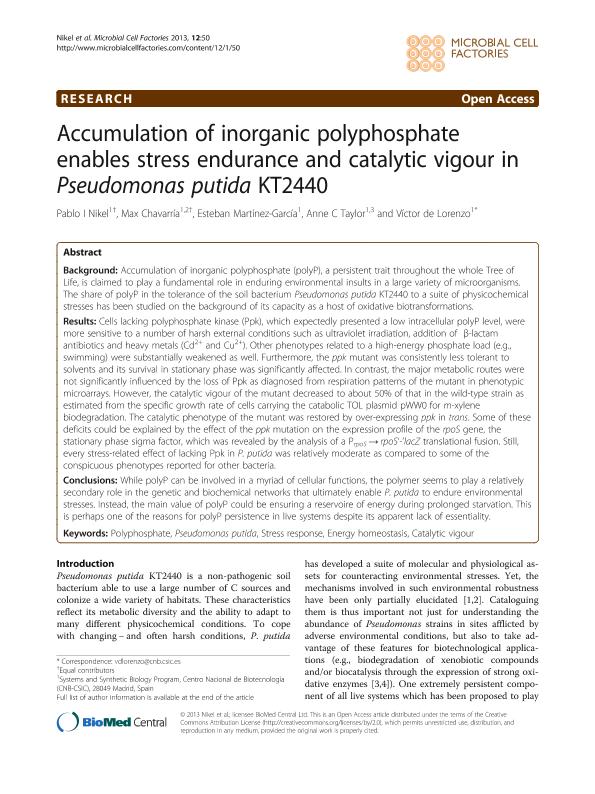Mostrar el registro sencillo del ítem
dc.contributor.author
Nikel, Pablo Ivan

dc.contributor.author
Chavarría, Max
dc.contributor.author
Martínez García, Esteban
dc.contributor.author
Taylor, Ann C.
dc.contributor.author
de Lorenzo, Víctor
dc.date.available
2017-02-06T18:35:19Z
dc.date.issued
2013-05
dc.identifier.citation
Nikel, Pablo Ivan; Chavarría, Max; Martínez García, Esteban; Taylor, Ann C.; de Lorenzo, Víctor; Accumulation of inorganic polyphosphate enables stress endurance and catalytic vigour in Pseudomonas putida KT2440; Biomed Central; Microbial Cell Factories; 12; 5-2013; 50-62
dc.identifier.issn
1475-2859
dc.identifier.uri
http://hdl.handle.net/11336/12527
dc.description.abstract
Background
Accumulation of inorganic polyphosphate (polyP), a persistent trait throughout the whole Tree of Life, is claimed to play a fundamental role in enduring environmental insults in a large variety of microorganisms. The share of polyP in the tolerance of the soil bacterium Pseudomonas putida KT2440 to a suite of physicochemical stresses has been studied on the background of its capacity as a host of oxidative biotransformations.
Results
Cells lacking polyphosphate kinase (Ppk), which expectedly presented a low intracellular polyP level, were more sensitive to a number of harsh external conditions such as ultraviolet irradiation, addition of β-lactam antibiotics and heavy metals (Cd2+ and Cu2+). Other phenotypes related to a high-energy phosphate load (e.g., swimming) were substantially weakened as well. Furthermore, the ppk mutant was consistently less tolerant to solvents and its survival in stationary phase was significantly affected. In contrast, the major metabolic routes were not significantly influenced by the loss of Ppk as diagnosed from respiration patterns of the mutant in phenotypic microarrays. However, the catalytic vigour of the mutant decreased to about 50% of that in the wild-type strain as estimated from the specific growth rate of cells carrying the catabolic TOL plasmid pWW0 for m- xylene biodegradation. The catalytic phenotype of the mutant was restored by over-expressing ppk in trans. Some of these deficits could be explained by the effect of the ppk mutation on the expression profile of the rpoS gene, the stationary phase sigma factor, which was revealed by the analysis of a P rpoS → rpoS‘-’lacZ translational fusion. Still, every stress-related effect of lacking Ppk in P. putida was relatively moderate as compared to some of the conspicuous phenotypes reported for other bacteria.
Conclusions
While polyP can be involved in a myriad of cellular functions, the polymer seems to play a relatively secondary role in the genetic and biochemical networks that ultimately enable P. putida to endure environmental stresses. Instead, the main value of polyP could be ensuring a reservoire of energy during prolonged starvation. This is perhaps one of the reasons for polyP persistence in live systems despite its apparent lack of essentiality.
dc.format
application/pdf
dc.language.iso
eng
dc.publisher
Biomed Central

dc.rights
info:eu-repo/semantics/openAccess
dc.rights.uri
https://creativecommons.org/licenses/by/2.5/ar/
dc.subject
Pseudomonas Putida Kt2440
dc.subject
Polyphosphate
dc.subject
Stress Resistance
dc.subject
Biotransformation
dc.subject.classification
Biología Celular, Microbiología

dc.subject.classification
Ciencias Biológicas

dc.subject.classification
CIENCIAS NATURALES Y EXACTAS

dc.title
Accumulation of inorganic polyphosphate enables stress endurance and catalytic vigour in Pseudomonas putida KT2440
dc.type
info:eu-repo/semantics/article
dc.type
info:ar-repo/semantics/artículo
dc.type
info:eu-repo/semantics/publishedVersion
dc.date.updated
2016-11-17T16:03:33Z
dc.journal.volume
12
dc.journal.pagination
50-62
dc.journal.pais
Reino Unido

dc.journal.ciudad
Londres
dc.description.fil
Fil: Nikel, Pablo Ivan. Consejo Superior de Investigaciones Cientificas. Centro Nacional de Biotecnologia; España. Consejo Nacional de Investigaciones Científicas y Técnicas. Centro Científico Tecnológico La Plata. Instituto de Investigaciones Biotecnológicas - Instituto Tecnológico Chascomús. Instituto de Investigaciones Biotecnológicas (sede Chascomús); Argentina
dc.description.fil
Fil: Chavarría, Max. Consejo Superior de Investigaciones Cientificas. Centro Nacional de Biotecnologia; España. Universidad de Costa Rica; Costa Rica
dc.description.fil
Fil: Martínez García, Esteban. Consejo Superior de Investigaciones Cientificas. Centro Nacional de Biotecnologia; España
dc.description.fil
Fil: Taylor, Ann C.. Consejo Superior de Investigaciones Cientificas. Centro Nacional de Biotecnologia; España. Harvard College; Estados Unidos
dc.description.fil
Fil: de Lorenzo, Víctor. Consejo Superior de Investigaciones Cientificas. Centro Nacional de Biotecnologia; España
dc.journal.title
Microbial Cell Factories

dc.relation.alternativeid
info:eu-repo/semantics/altIdentifier/url/http://microbialcellfactories.biomedcentral.com/articles/10.1186/1475-2859-12-50
dc.relation.alternativeid
info:eu-repo/semantics/altIdentifier/url/http://dx.doi.org/10.1186/1475-2859-12-50
Archivos asociados
